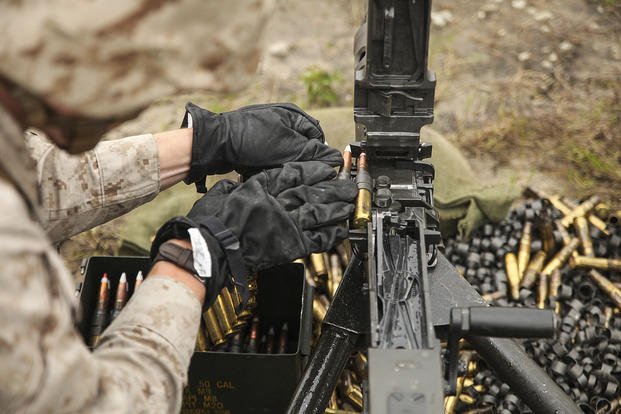The Marine Corps has been testing the performance of a polymer-cased .50-caliber ammunition in a lab environment, and leathernecks soon will get a chance to see how the lighter rounds hold up in the field.
Marines at the schools of infantry on both coasts, Advanced Machine Gunners Course, and 1st and 2nd Amphibious Assault Battalions will likely be the first to try out the new round for the "Ma Deuce" M2 machine gun, said Kelly Flynn, a Marine Corps Systems Command spokeswoman. Officials then want members of I and II Marine Expeditionary Forces to test the round on static and maneuver ranges, she said.
The evaluations, which are set to start later this year and run into 2022, could determine whether Marine Corps and Army mounted combat units will swap the traditional brass .50-caliber round for a lighter polymer version. The lighter casings cut the weight of the machine gun rounds by about a quarter, Brig. Gen. A.J. Pasagian, head of Marine Corps Systems Command, told reporters Thursday.
Read Next: CNO Says Navy Department Has Strong Case for Getting Bigger Slice of Defense Budget
Marine officials announced last year they planned to invest $10 million in the polymer-cased .50-caliber rounds for user evaluations. The lab tests so far have produced promising results, Pasagian said.
The rounds have been exposed to temperature changes to see how they perform compared with brass versions. The trajectory and performance have so far been on par with brass rounds, Pasagian said.
"But what we want to do ... is expose the round to the more operationally realistic environment in which we typically see Marines, which is kind of not so pretty," he said. "It's very austere, a lot of sand, grime and dirt. There are days where you don't get the opportunity to clean the weapon as often as you'd like or maintain it with lubrication or other means, so those are the things we want to check out."
The Marine Corps is on a mission to lighten the weight of gear required for warfighting, especially as it returns to naval operations after decades of ground-based combat. Pasagian said it's not just ground units that are excited about the idea of lighter ammunition, but logisticians and aircrews, too.
"A lot of optimism here, but we're going to bring it out and we're going to put it through its paces," he said.
Other services are experimenting with polymer ammunition, too. Adopting the lighter rounds could put an end to a decades-long effort to replace brass-cased ammunition. The Army wants to replace its brass-cased 7.62mm ammo, and the Navy is working to develop lightweight cartridges that perform as well as traditional options.
Combined, Pasagian said, the results of those experiments could lead to changes for the joint force.
"Just the fuel savings alone [could be] a ... strategic advantage," he said.
-- Gina Harkins can be reached at gina.harkins@military.com. Follow her on Twitter @ginaaharkins.
Related: The Marine Corps Is Experimenting with a Concept that Could Reshape the Infantry













